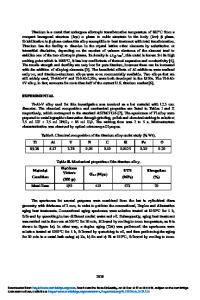On the Influence of Titanium Alloy Composition and Layer Thickness on the Mechanical Properties of a Polyimide Substrate
- PDF / 1,800,872 Bytes
- 6 Pages / 417.6 x 639 pts Page_size
- 20 Downloads / 616 Views
Failure Analysis and Reliability Department,
**
Multi-Chip Module Group,
Institute of Microelectronics, 11 Science Park Rd., Science Park II, Singapore - 117685. *** Division of Materials Engineering, School of Applied Science, Nanyang Technological University, Singapore- 639798. ABSTRACT Metal-polymer bilayers and multilayers are being increasingly used in the microelectronics industry. In many cases, the reliability of the device or the package is determined by the mechanical behavior of these composite layers. Finite element analyses are being widely used to model these systems. An accurate experimental understanding of the mechanical behavior of these systems would further enhance the usefulness of such analyses. The present study focuses on the mechanical behavior of composite bilayers consisting of polyimide and sputtered Ti and Ti alloy thin films. Tensile tests and stretch-deformation tests have been performed on bilayers consisting of a polyimide substrate sputter-coated individually with a 50 nm and a 500 nm Ti layer, a 500 nm Ti-Cu layer, and a 500 nm Ti-Ni layer. Tensile moduli, stresses for 0.2%, 2% and 15% offset strains, and strains to failure have been obtained and compared. These values are discussed with reference to the known mechanical properties of the individual layers in the composite material.
INTRODUCTION Metal-polymer structures are finding increasing applications in various areas of microelectronic packaging, including flexible substrates (polyimide substrates with metal interconnects), multi-chip modules (MCM) (interlayer dielectrics and interconnects), and so
on. Polyimide is widely used as an interlayer dielectric because of its high thermal stability (>300'C), low dielectric constant, chemical stability, and ease of processing [1]. For example, low cost multi-chip modules can consist of five layers of metal (like aluminum)polyimide multilayer stacks [1]. However, several concerns exist in the use of such metalpolymer composite structures. Cracking and delamination of the dielectric layer can occur due to moisture absorption and hence pose a reliability problem [1]. Further, differences in the thermal expansion coefficients of the metal and polyimide result in thermal-mechanical stresses. Thus, the performance of the package or device is determined by the reliability of such composite structures. To design and use these polymer-metal thin films, one has to understand the properties of these films and how they relate to the reliability and performance of structures comprised of these thin films. Finite Element Modeling (FEM) is currently being used extensively for the analysis of complex multilayer stacks that are often used in microelectronic packaging. Modeling helps 203 Mat. Res. Soc. Symp. Proc. Vol. 515 © 1998 Materials Research Society
in predicting or verifying the behavior of these multilayers during thermal-mechanical cycling, reliability testing, and service. However, important ingredients of such simulations are the properties of the individual layers themselves and th
Data Loading...











